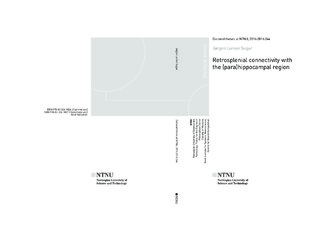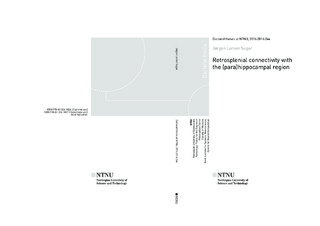| dc.contributor.advisor | Witter, Menno P. | |
| dc.contributor.author | Sugar, Jørgen Larsen | |
| dc.date.accessioned | 2017-03-17T14:21:03Z | |
| dc.date.available | 2017-03-17T14:21:03Z | |
| dc.date.issued | 2016 | |
| dc.identifier.isbn | 978-82-326-1827-9 | |
| dc.identifier.issn | 1503-8181 | |
| dc.identifier.uri | http://hdl.handle.net/11250/2434572 | |
| dc.description.abstract | The hippocampal formation and parahippocampal region (HF-PHR) receives input from a variety of cortical and subcortical structures, and one of the cortical regions which are heavily interconnected with HF-PHR is the retrosplenial cortex (RSC; Wyss and Van Groen, 1992). RSC is known to be important for a number of cognitive functions, and in both rodents and humans the RSC contribution to visuospatial cognition and memory has recently been reviewed in detail (Vann et al., 2009; Ranganath and Ritchey, 2012). The similar functional attributes of RSC and HF-PHR and the dense connections between the regions suggest a relationship. However exactly which HF-PHR subdivisions are connected with which part of RSC, the topographies of the connections within these subregions and how information carried by these connections are integrated in the receiving subregion is unknown.
In this thesis I explored anatomical connections between HF-PHR and RSC at several levels. In the first part of the thesis all published anatomical tract-tracing experiments which comprise HF-PHR - RSC connections were reanalyzed. All reported projections within and between HF-PHR and RSC were presented in an interactive connectome.
In the second part I explored the synaptic organization and postsynaptic targets of one of these connections namely the projection originating in RSC and terminating in medial entorhinal cortex (MEC), a subregion within PHR. I showed that RSC projects densely to layer V of MEC, with very few fibers targeting layer III. An ultrastructural assessment of the synaptic complexes and optogenetic stimulation of these fibers in an in vitro slice preparation indicated that the majority of RSC synapses in MEC layer V are excitatory. I further identified the layer V neurons postsynaptic to these synapses. The electron microscopical data show a striking dominance of spines of putative principal neurons as targets for RSC inputs. Confocal data and optogenetic data indicate that among the postsynaptic targets are spiny principal cells which project to superficial layers of MEC.
In the third and fourth part I took a developmental approach to study how the interconnections between the two regions develop. To this end I used classical retro- and anterograde tracers injected in differently aged rats. The development of the anatomical connections and the development of the topographical distribution of these connections from postnatal day (P)1 to approximately P28 were characterized. I showed that developing RSC - HF-PHR interconnections are organized in a topographical manner, similar to the adult situation and that this topographical organization is present already when the first axons arrive their termination site.
I thus concluded that information from RSC may reach HF through pyramidal neurons in layer V of MEC which issue projections to the superficial layers of MEC. Neurons in the latter layers may relay information from RSC to HF since these layers harbor neurons projecting to HF. Alternative multisynaptic pathways connecting RSC via PHR to HF likely include RSC projections to postrhinal cortex and presubiculum. Both structures receive RSC inputs among others in superficial layers, which harbor neurons projecting to superficial layers of MEC. The early development of the reciprocal connections between RSC and HF-PHR, already at an early postnatal stage, before neurons are functionally differentiated, suggests that RSC-PHR interconnections are organized by experience independent mechanisms. This experience independent topographic organization suggests that RSC and HF-PHR are parts of one tightly coupled functional system and that RSC - HF-PHR interaction is necessary for proper functioning of the two regions. | nb_NO |
| dc.language.iso | eng | nb_NO |
| dc.publisher | NTNU | nb_NO |
| dc.relation.ispartofseries | Doctoral theses at NTNU;2016:244 | |
| dc.relation.haspart | Paper 1: Sugar, Jørgen Larsen; Witter, Menno; van Strien, Niels; Cappaert, Natalie L.M..The retrosplenial cortex: intrinsic connectiviuty and connections with the (para)hippocampal region in the rat. An interactive connectome. Frontiers in Neuroinformatics 2011 ;Volum 5.(7) | |
| dc.relation.haspart | Paper 2: Czajkowski, Rafal; Sugar, Jørgen L; Zhang, Sheng Jia; Couey, Jonathan Jay; Ye, Jing; Witter, Menno. Superficially Projecting Principal Neurons in Layer V of Medial Entorhinal Cortex in the Rat Receive Excitatory Retrosplenial Input. Journal of Neuroscience 2013 ;Volum 33.(40) s. 15779-15792. http://doi.org/10.1523/JNEUROSCI.2646-13.2013 | |
| dc.relation.haspart | Paper 3: Sugar, Jørgen; Haugland, KG; Witter, Menno. Development of anatomical connections between retrosplenial cortex and the (para)hippocampal region. FENS; 2014-07-05 - 2014-07-09. Copyright Sugar and Witter. This article is distributed under the terms of the Creative Commons Attribution License. | |
| dc.relation.haspart | Paper 4: Haugland, Kamilla G.; Sugar, Jørgen og Witter, Menno P. Development of projections from the (para)hippocampal region to the retrosplenial cortex in the rat. Not included due to copyright. | |
| dc.title | Retrosplenial connectivity with the (para)hippocampal region | nb_NO |
| dc.type | Doctoral thesis | nb_NO |
| dc.subject.nsi | VDP::Medical disciplines: 700::Clinical medical disciplines: 750::Neurology: 752 | nb_NO |

